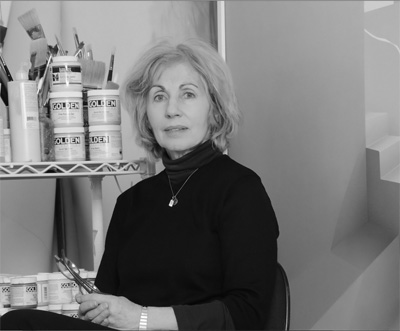Artist Statement
My fascination with architecture began during my college days, when I spent many hours photographing Victorian houses in Saratoga Springs, New York. It has since led me to a personal style of art that captures architecture more abstractly, with light, space and color divorced from any particular time and place.
In my post-graduate years at the University of Pennsylvania, it was architect Louis Kahn who gave me inspiration with his poetic musings. I also began using pastels, drawing the barrel vaults and sculpture studios in the university's 19th-century Frank Furness building. These early experiences, as well as my love of travel, later led me to find my subject matter in the vernacular dwellings of the Mediterranean, the crumbling facades of Cuba, and the sculptural forms of wind-filled sails.
In the early 1970s I was attracted to the work of the photorealist painters, especially Richard Estes, but I quickly realized that the profusion of details, the complexity, and the masculinity of their work was all wrong for me. I looked to earlier painters: the prison series of 16th-century Italian Piranesi, surrealists like Giorgio DeChirico, American painters Edward Hopper and Charles Sheeler, and the American Precisionists. I developed a style of reductionism, looking for abstraction in the geometry of my subjects, more akin to the simple forms of Mondrian than the swirling drama of Kandinsky. I was also attracted to a hint of the sublime, a luminous moment often tinged with emptiness or loneliness.
My painterly process begins with a moment of seeing. On my travels I would take thousands of photographs. Back in the studio, I would select several images and from them make a series of pastel works. I would use soft pastels, almost pure pigment, but instead of using the edge I would press it into the paper with my fingers. Then I would choose a few of these to enlarge into airbrushed paintings. I apply dozens of layers of spray paint, building up a luminous surface without thickness. At each stage, the slowness and meditative quality of the technique reduces the nonessential elements and moves toward abstraction.
For some years I used both my own photos and those sourced from appropriated images, architectural models, renderings, and images captured from video. Since the '70s, many artists have used photography in a method at odds with Modernist ideas of authenticity and singularity. Artists from the " Pictures Generation" saw borrowing an image as visual recycling.
Critic Janet Koplos said of my paintings in 2011, "If one were to attempt an interpretation of this body of work, enclosure and protection are surely among the possible motives. Borstein stands in these places; she experiences them as geometry and color, the useful elements of art. But her interest in light as well as color, in space as well as plane gives each setting breathing room. I'm reminded of Tadeo Ando's early architecture, with its empty concrete courtyards in which sun, rain and wind mark the presence of nature. Borstein captures the same clarity and heightening of the senses in her paintings."
I experienced Ando's architecture firsthand during an extended trip to Japan in 2007, when I lived and worked in buildings he designed on the island of Naoshima. I presented his iconic spaces such as Rokko and the Green Wall, independent of their function. I am not a recorder of the world, yet I still dealt with the intrinsic elements of architecture: space, form, light, and color.
Over the years my exhibitions became more conceptual and abstract, but still connected to places that hold meaning for me. My 2013 exhibit "Built/Unbuilt" contained the painting "Still Bend," from a Frank Lloyd Wright House I stayed in; models from a Frank Lloyd Wright exhibit at the Milwaukee Art Museum; and images of Louis Kahn's buildings that were never built, based on his renderings. I felt I was finding a new use for these symbols of American icons.
I recently exhibited paintings based on the houses of Mexican architect Luis Barragan, whose buildings I have long admired even though I have never seen them except in newspapers, books, or on the computer. His buildings are rich with the echoes of traditional construction and bright color found in vernacular architecture. I began recreating them from low-resolution internet images, transforming them into large airbrush paintings, both meditating on the spaces and giving them new agency. Several paintings from this series were shown this past summer at the Adirondack History Museum in Elizabethtown, New York.
In my most recent series, I am putting images through more technical permutations and combinations through computer manipulations until they are almost totally unrecognizable from their original sources. In this new series, called "Sketches" there is only an echo of the original image, with the meaning less explicit in relation to the specific photographs and more a pure celebration of painting.
Elena Borstein, 2022
